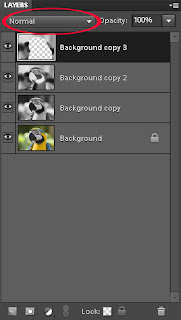Here's an overview of what we learned in class today:
What's the difference? .png, .jpg, .tif, .gif, Click on over
here for details. For our class - the biggest difference is how we can use the file. Since we will be working in Adobe Photoshop Elements our work will usually have the extension .psd (photoshop document). A photoshop document or .psd can only be used in that program. To make it "portable" we need to save it as an interchangeable file for example: .jpg or .png. For our purposes, we'll stick with .jpg.
TIP: if your file won't open in another program, it might not be the right format.
What are layers? You'll hear me talk a lot about layers in class today. Layers are part of what makes Photoshop Elements magical. Imagine you want to go outside in the freezing cold. Your mom says, "bundle up!" Bundle up to a mom means: wear lots of layers. Put a shirt on over your undershirt. Put a sweater on over your shirt, add a jacket on top of your sweater. Add a scarf, wear mittens and a hat. You get it right? It's cold! Let's say your shirt is something very exciting with no sleeves, yellow stripes and maybe a little T-Rex or two. The sweater you put on top of it is going to be a solid color with a UCLA logo and long sleeves. When you add that sweater on top of your shirt no one knows that you're wearing yellow stripes underneath. And when you put that coat on no one can tell you've got that sweater on underneath...We just see what's on top. So why wear a yellow striped shirt at all? The answer, in this case, is that it keeps you warm. It also shows us about your personality.
In Photoshop a layer can work the same way: we only see what's on top. So, if something is showing that you don't want to show, move it down a layer or two. Now, let's imagine that your coat is made of clear plastic. Your friends can see your sweater now and they know you're a big UCLA fan. What if your sweater had patches of clear plastic so your friends could also see that awesome, yellow T-Rex shirt? That'd be cool. And that's more the way layers work in Photoshop. Layers are all transparent until you add something too them. You can cover up or uncover any part of the image you're working on. Plus, you can move stuff around. No more typing in a line - everything can get up and move. Where do you want those mittens? On your head? Feet? You name it. if it is on a layer, it can be manipulated.
So keep these things in mind:
1) the whole point of layers is to protect the original image (the coat protects the original YOU)
2) layers can be moved up or down to reveal or hide different things
3) if you want to move something (words, an image, a single letter) put it on a separate layer. (We don't usually put our boots and socks on at the exact same time...that'd be quite a trick!)
The best way to learn about layers is to start using them. So let's play!
One last thought: BACK UP YOUR WORK - SAVE, SAVE, SAVE!!



